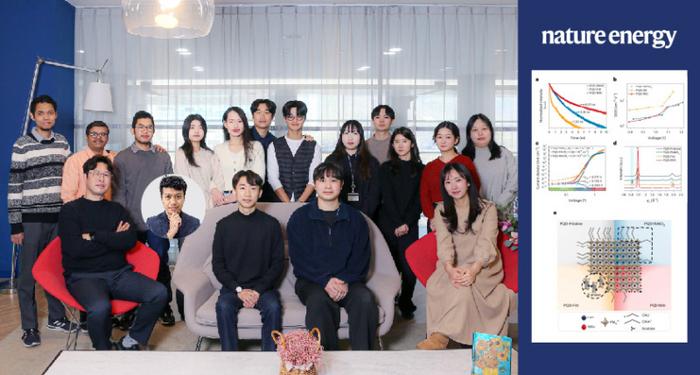A groundbreaking research breakthrough in solar energy has propelled the development of the world’s most efficient quantum dot (QD) solar cell, marking a significant leap towards the commercialization of next-generation solar cells. This cutting-edge QD solution and device have demonstrated exceptional performance, retaining their efficiency even after long-term storage. Led by Professor Sung-Yeon Jang from the School of Energy and Chemical Engineering at UNIST, a team of researchers has unveiled a novel ligand exchange technique. This innovative approach enables the synthesis of organic cation-based perovskite quantum dots (PQDs), ensuring exceptional stability while suppressing internal defects in the photoactive layer of solar cells.

Credit: UNIST
A groundbreaking research breakthrough in solar energy has propelled the development of the world’s most efficient quantum dot (QD) solar cell, marking a significant leap towards the commercialization of next-generation solar cells. This cutting-edge QD solution and device have demonstrated exceptional performance, retaining their efficiency even after long-term storage. Led by Professor Sung-Yeon Jang from the School of Energy and Chemical Engineering at UNIST, a team of researchers has unveiled a novel ligand exchange technique. This innovative approach enables the synthesis of organic cation-based perovskite quantum dots (PQDs), ensuring exceptional stability while suppressing internal defects in the photoactive layer of solar cells.
“Our developed technology has achieved an impressive 18.1% efficiency in QD solar cells,” stated Professor Jang. “This remarkable achievement represents the highest efficiency among quantum dot solar cells recognized by the prestigious National Renewable Energy Laboratory (NREL) in the United States.”
The increasing interest in related fields is evident, as last year, three scientists who discovered and developed QDs, as advanced nanotechnology products, were awarded the Nobel Prize in Chemistry. QDs are semiconducting nanocrystals with typical dimensions ranging from several to tens of nanometers, capable of controlling photoelectric properties based on their particle size. PQDs, in particular, have garnered significant attention from researchers due to their outstanding photoelectric properties. Furthermore, their manufacturing process involves simple spraying or application to a solvent, eliminating the need for the growth process on substrates. This streamlined approach allows for high-quality production in various manufacturing environments.
However, the practical use of QDs as solar cells necessitates a technology that reduces the distance between QDs through ligand exchange, a process that binds a large molecule, such as a ligand receptor, to the surface of a QD. Organic PQDs face notable challenges, including defects in their crystals and surfaces during the substitution process. As a result, inorganic PQDs with limited efficiency of up to 16% have been predominantly utilized as materials for solar cells.
In this study, the research team employed an alkyl ammonium iodide-based ligand exchange strategy, effectively substituting ligands for organic PQDs with excellent solar utilization. This breakthrough enables the creation of a photoactive layer of QDs for solar cells with high substitution efficiency and controlled defects.
Consequently, the efficiency of organic PQDs, previously limited to 13% using existing ligand substitution technology, has been significantly improved to 18.1%. Moreover, these solar cells demonstrate exceptional stability, maintaining their performance even after long-term storage for over two years. The newly-developed organic PQD solar cells exhibit both high efficiency and stability simultaneously.
“Previous research on QD solar cells predominantly employed inorganic PQDs,” remarked Sang-Hak Lee, the first author of the study. “Through this study, we have demonstrated the potential by addressing the challenges associated with organic PQDs, which have proven difficult to utilize.”
“This study presents a new direction for the ligand exchange method in organic PQDs, serving as a catalyst to revolutionize the field of QD solar cell material research in the future,” commented Professor Jang.
The findings of this study, co-authored by Dr. Javid Aqoma Khoiruddin and Sang-Hak Lee, have been published online in Nature Energy on January 27, 2024. The research was made possible through the support of the ‘Basic Research Laboratory (BRL)’ and ‘Mid-Career Researcher Program,’ as well as the ‘Nano·Material Technology Development Program,’ funded by the National Research Foundation of Korea (NRF) under the Ministry of Science and ICT (MSIT). It has also received support through the ‘Global Basic Research Lab Project.’
Journal Reference
Havid Aqoma, Sang-Hak Lee, Imil Fadli Imran, et al., “Alkyl ammonium iodide-based ligand exchange strategy for high-efficiency organic-cation perovskite quantum dot solar cells,” Nature Energy (2024).
Journal
Nature Energy
Article Title
Alkyl ammonium iodide-based ligand exchange strategy for high-efficiency organic-cation perovskite quantum dot solar cells
Article Publication Date
26-Jan-2024




